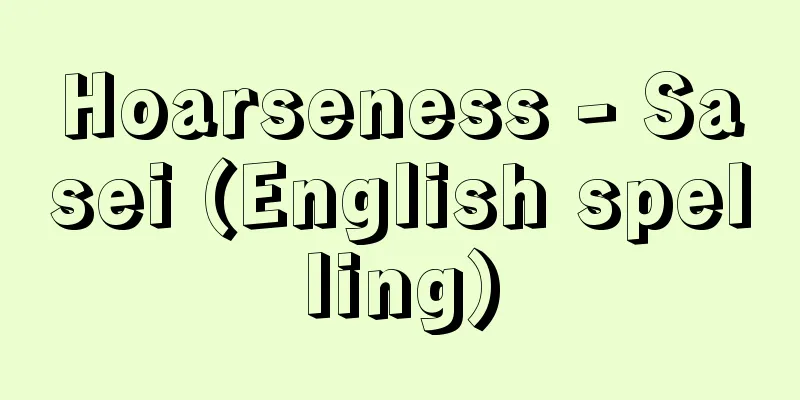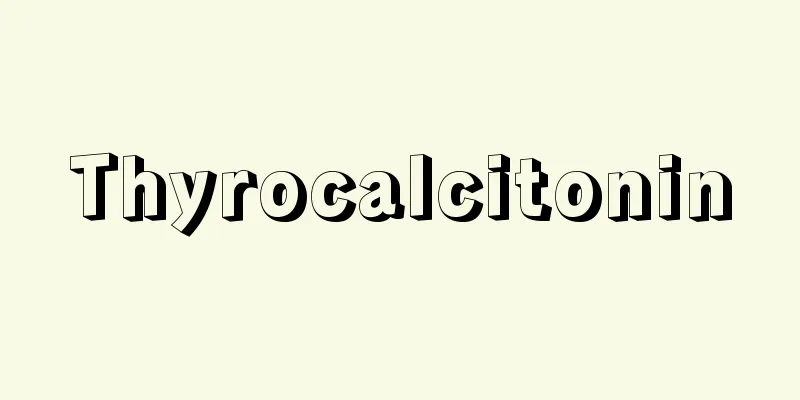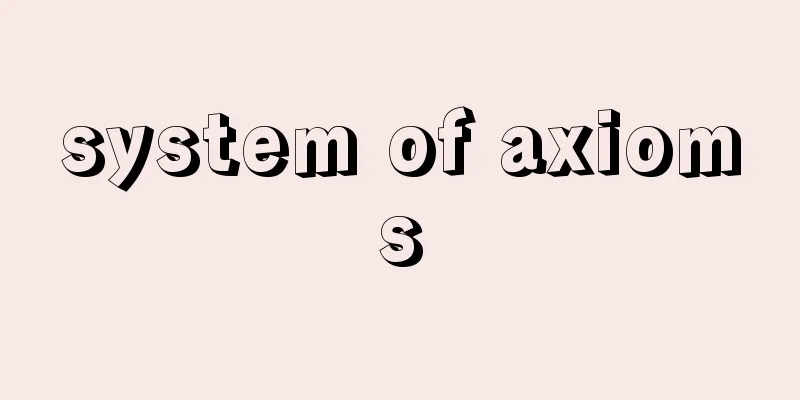Hoarseness - Sasei (English spelling)

What are the symptoms? The voice flows from the lungs. Hoarseness, or "raspy voice," is a comprehensive abnormality in the tone of the voice, and can be described as a state in which the vibration of the vocal cords is disturbed. The main diseases that actually cause hoarseness are organic lesions of the vocal cords (Figure 8) and motor paralysis, but functional disorders are also possible. Testing and diagnosisThe pathology of voice disorders can be considered to be disorders in the four elements of voice: ① pitch, ② loudness, ③ duration, and ④ timbre. Therefore, a single method is insufficient for the evaluation of hoarseness, and it is necessary to evaluate it using various scales. The degree of the disorder can be easily evaluated by the auditory impression of the voice or by measuring the maximum duration of the voice. There are also tests using special equipment, such as acoustic analysis and speech function tests. To confirm organic lesions, laryngeal fiberscopes and laryngeal Treatment methods1. Conservative treatment Drug treatment Hoarseness is often caused by acute or chronic laryngitis. Anti-inflammatory drugs and local inhalation therapy (nebulizer therapy, inhaled steroids) are the main treatments for inflammation. In cases of severe edema, systemic administration of steroids may be required. ●Voice training In cases of functional dysphonia, the condition may be improved by teaching vocal techniques through voice training. In cases of hypertonic phonation, relaxation techniques are used, and in cases of incomplete glottal closure, pushing techniques are used. Vocal hygiene Basic guidance items such as vocal rest, proper vocal technique, smoking cessation, and lifestyle changes are called "vocal hygiene." It is especially important to maintain vocal hygiene for voice disorders caused by vocal overuse. 2. Surgical treatment The surgical methods include endoscopic surgery under local anesthesia and microlaryngoscopy under general anesthesia. Vocal cord polyp (Figure 8, a), vocal cord nodule (Figure 8, b), polypoid vocal cord (Figure 8, c), vocal cord Tumor lesions Laryngeal papilloma (Fig. 8 d), larynx It is often difficult to distinguish based on laryngeal findings alone, so a tissue biopsy is performed endoscopically or via microlaryngoscopy to make a pathological diagnosis. In treatment, complete removal of the lesion takes priority over improving the voice disorder. ●Vocal cord paralysis (recurrent laryngeal nerve paralysis) Controls the internal muscles of the larynx Spasmodic dysphonia Injecting botulinum toxin to paralyze the laryngeal muscles is effective, but the effect is temporary, lasting 3 to 6 months, and repeated treatments are required. In addition, it is difficult to obtain the drug in Japan, and treatment is only available at a limited number of facilities. Recently, attempts have been made to perform microlaryngeal surgery, such as intrinsic muscle resection and thyroplasty. Atrophic lesions For atrophied vocal cords, intracordal injection ( It is effective for vocal muscle atrophy caused by recurrent laryngeal nerve paralysis, Jiro Tayama "> Figure 8 Organic lesions causing hoarseness "> Figure 9 Microscopic direct laryngeal surgery Source: Houken “Sixth Edition Family Medicine Encyclopedia” Information about the Sixth Edition Family Medicine Encyclopedia |
どんな症状か 声は、肺から流れ出る「 嗄声、すなわち「かすれ声」は、音色に関する総合的な声の異常であり、声帯の振動が乱れた状態ともいえます。実際に嗄声を来す疾患としては、声帯の器質的病変(図8)や運動麻痺が主体ですが、機能的な障害も考えられます。 検査と診断音声障害の病態としては、音声の①高さ、②大きさ、③長さ、④音色の4つの要素での障害が考えられます。したがって嗄声の評価は単一の方法では不十分であり、さまざまな尺度で評価する必要があります。 声の聴覚的印象からその程度を評価する方法や、音声の最大持続時間の測定は、簡便にできる方法です。音響分析や発声機能検査など、特殊な装置を用いて行う検査もあります。 器質的病変を確認するためには、喉頭ファイバースコープや喉頭 治療の方法①保存的治療 ●薬物治療 嗄声の多くは、急性喉頭炎や慢性喉頭炎などが原因になります。消炎薬や局所吸入治療(ネブライザー療法、吸入ステロイド薬)による消炎が主体になります。浮腫が高度な場合には、ステロイド薬の全身投与が行われることもあります。 ●音声訓練 機能性発声障害などでは、音声訓練による発声法の指導で改善する場合もあります。過緊張発声ではリラクゼーション法、声門閉鎖不全型の発声ではプッシング法などを用います。 ●声の衛生 声の安静、適切な発声方法、禁煙、生活習慣の改善などは、基本的な指導項目で、「声の衛生」と呼ばれます。とくに声の酷使による音声障害に対しては、声の衛生を十分守ることが重要になります。 ②外科的治療 手術方法としては、局所麻酔による内視鏡手術、全身麻酔による顕微鏡下喉頭 ●良性 声帯ポリープ(図8のa)、声帯結節(同、b)、ポリープ様声帯(同、c)、声帯 ●腫瘍性病変 喉頭乳頭腫(にゅうとうしゅ)(図8のd)、喉頭 喉頭所見のみでは判別が困難な場合も多く、病理診断のために、内視鏡下もしくは喉頭微細手術での組織生検が行われます。 治療においては、音声障害の改善よりも病変の完全除去が優先になります。 ●声帯麻痺(反回神経麻痺) 喉頭の内部の筋群を支配する ●けいれん性発声障害 ボツリヌス毒素を注入して喉頭内筋を麻痺させる方法が効果的ですが、その効果は3~6カ月と一時的で、繰り返しの治療が必要になります。また、日本では薬剤の入手が難しく、限られた施設でしか治療を受けられないという問題もあります。 最近では、喉頭微細手術による内筋切除や甲状軟骨形成術なども試みられています。 ●萎縮性病変 萎縮した声帯に対しては声帯内注入術( 反回神経麻痺による声帯筋の萎縮には有効ですが、 田山 二朗 "> 図8 嗄声を来す器質的病変 "> 図9 顕微鏡下喉頭直達鏡手術 出典 法研「六訂版 家庭医学大全科」六訂版 家庭医学大全科について 情報 |
<<: Sha-jing Ruins (English name)
>>: Sassoon family - Sassoon-ke
Recommend
Mollet, C. (English spelling) MolletC
… [Establishment of French-style gardens] Italian...
Nomura Securities [Stock] - Nomura Shoken
The top of the four major securities companies and...
Crown - Headgear
...Then there are the masks, which have been used...
Cannabich - Johann Christian Cannabich
German musician. One of the outstanding composers...
forum
A general term for the movements that formed the c...
EPROM - Electronic read only memory
A rewritable read-only memory. Erasable ROM; abbre...
Lindeman, RL
…Similarly, in an ecosystem, the efficiency of en...
boreal floral kingdom
… The currently widely accepted method of dividin...
Spal'vin, EG (English spelling)
…Until the beginning of the 20th century, Japanes...
Cicadellidae
…General term for insects of the order Hemiptera,...
Suo-Nada Sea
This is the westernmost area of the Seto Inland...
Yagyu Jubei - Yagyu Jubei
A swordsman in the early Edo period. The eldest so...
For sale document - Urikumon
…Therefore, in the Kamakura period, the disputes ...
Finale - Oozume
A term used in theater scripts. It refers to the ...
Panduranga
...According to a surviving Sanskrit inscription,...









